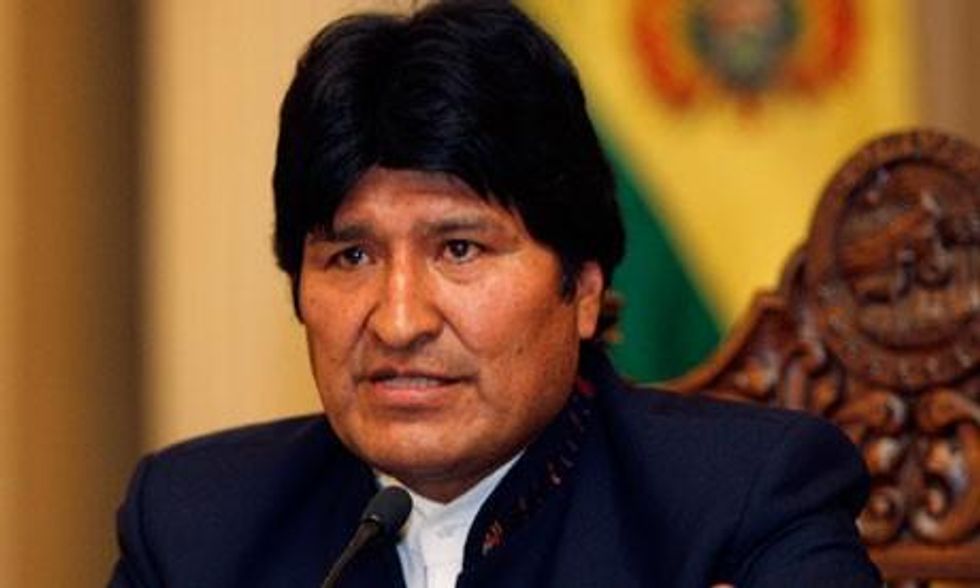Gabriela Oviedo is a fashion model and TV personality. She is a 28-year-old brunette, almost six feet tall. Born in the Bolivian province of Santa Cruz, she was elected as the national beauty queen in 2003. In 2004, Gabriela took part in the Miss Universe pageant. There she was asked to name one of the biggest misconceptions about her country. In awkward English, she answered: "Um ... unfortunately, people that don't know Bolivia very much think that we are all just Indian people from the west side of the country. It's La Paz, all the image that we reflect, is that poor people and very short people and Indian people ... I'm from the other side of the country, the east side, and it's not cold, it's very hot and we are tall and we are white people and we know English."
Gabriela's answer, heavy with racism, raised such a wave of outrage in her country that she was forced to give up the contest. Two in every three Bolivians are indigenous people. Her answer, however, was not an isolated occurrence. It reflects the persistence of a white, deeply anti-indigenous Bolivia, which survives today even though deep changes have been introduced, including the approval of anti-racist legislation.
In spite of the force of racial discrimination, on 22 January 2006, the Aymara Indian and cocalero unionist Evo Morales was elected president. Since then, the Bolivian state and society have undergone a profound transformation. The country has been decolonised. Indigenous people hold key cabinet positions in government and also in political institutions, while their standard and quality of life have been notably improved.
In the past six years, Bolivia has become one of the Latin American countries most successful at improving its citizens' standard of living. Economic indicators such as low unemployment and decreased poverty, as well as better public healthcare and education, are outstanding.
Between 2005 and 2010, the proportion of those in moderate poverty went down from 60% to 49.6%, while extreme poverty fell from 38% to 25%. Likewise, the unemployment rate decreased from 8.4% to 4%. The United Nations Development Programme (UNDP) points out that Bolivia is the top country in Latin America in terms of transferring resources to its most vulnerable population - 2.5% of its GNP.
According to Alicia Barcena, executive secretary of the UN Economic Commission for Latin America and the Caribbean, "Bolivia is one of the few countries that has reduced inequality ... the gap between rich and poor has been hugely narrowed."
One of the key tools in reducing poverty has been the expansive distribution of economic surplus among the population, through direct cash transfers and bonds in programmes such as Juancito Pinto and Juana Azurduy, the Renta Dignidad, and salary increases. These payments have contributed to increasing the number of children attending school, broadening the coverage of public pensions to alleviate extreme poverty among senior citizens, and delivering subsidies to mothers excluded from social security, so as to reduce children's mortality and expand pre- and post-natal attention.
Bolivia has been declared an illiteracy-free country. Income redistribution has fuelled a 7% increase in the internal consumption of electricity, purified water and domestic gas among sectors that didn't have access to those services before.
During 2011, the country's economy grew at 5.3%, above the Latin American average. It is not an isolated event. The economy has been constantly expanding since 2007, averaging 4.5% a year.
These economic and social successes have been attained following an alternative route to neoliberalism. Evo Morales's government did the opposite of what the Washington Consensus recommends: it nationalised hydrocarbons, electricity, telecommunications and mining; renegotiated the presence of direct foreign investment in the country; implemented an expansive fiscal policy and closed borders to the free importation of economically strategic products. The state took 34% of the economy under its control.
This exceptional performance was obtained even though remittances decreased, the United States revoked the most-favoured nation status for some Bolivian products, and in spite of a global recession. The oil income is now three times that of 2005. The tax revenues went up. The international currency reserves are up to more than $12bn dollars. The banking savings-and-loans system has been "Bolivian-ised" and the external debt has been reduced. The bid now is that Bolivia will take a "big industrial leap" in the next five years so that it ceases to be an extractor of natural resources and begins to export value-added goods.
However, the Bolivian story is not one of "progress", but of forging an alternative economy, one which stems from the original peoples and nations. At the centre of its proposal is the Suma Qamana, a notion that has been incorporated into the constitution and that is translated as "living well", meaning to be in harmony and equilibrium with other people and with nature. It is a proposal born in the community, and it is based, not in the logic of economic profitability, but on producing goods according to nature. As Evo Morales has said: "We don't believe in the linear, cumulative conception of progress and of an unlimited development at the cost of other people and of nature. To live well is to think not only in terms of per capita income, but of cultural identity, community, harmony among ourselves and with Mother Earth."
Raul Garcia Linera, one of Bolivia's principal political strategists, describes the current process of transformation in his country as trying to change the engine of a car while it's moving. It is, no doubt, a genuine, bold and encouraging attempt.

